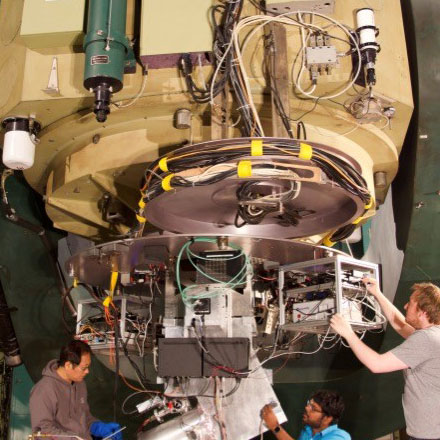Join us for a FREE Webinar
Optics and Astronomy
Wednesday, June 20, 2018 1:00 PM - 2:00 PM EDT
|
|
|

|
What tools and equipment will be needed for 21st century astronomy? In this webinar, you will learn about innovative optical approaches to astronomy to support research at a global level.
The webinar will cover optical and IR instruments for astronomy, with a particular focus on how innovations in adaptive optics and IR spectroscopy are pushing the technical and scientific envelope. The Gemini infrared multi-object spectrograph (GIRMOS), a new instrument being developed for the Gemini observatory, will be described. GIRMOS will take advantage of the latest developments in adaptive optics and imaging spectroscopy to probe the distant universe.
The speaker will discuss how these optical tools can be used to make extremely sensitive and high fidelity measurements of astronomical objects at next-generation extremely large optical telescopes like the Thirty Meter Telescope (TMT). The design and fabrication of novel astronomical instrumentation will be covered from both a scientific and an engineering standpoint.
About the speaker:
Suresh Sivanandam, Ph.D., is an assistant professor at the Dunlap Institute for Astronomy and Astrophysics at the University of Toronto. He studies the formation and evolution of galaxies in clusters; and one focus of his research is a spectroscopic survey of nearby galaxies to see if their stellar populations differ significantly from predictions. This survey will be conducted with a unique instrument that Sivanandam and his collaborators have recently commissioned at Kitt Peak, USA: the Wide Integral-Field Infrared Spectrograph, or WIFIS.
In addition to WIFIS, Sivanandam is a key member in many instrument projects. At Dunlap, he is principal investigator for GIRMOS, a facility-class instrument that will be commissioned at the 8-meter Gemini Observatory in 2023. He is also involved in the development of future capabilities for TMT, where GIRMOS will serve as a pathfinder for a future TMT instrument.
Sivanandam became an assistant professor at the Dunlap Institute in 2015. He was a Dunlap Fellow at the University of Toronto from 2010-2015. He received his Ph.D. in Astronomy, with a minor in optical sciences, from the University of Arizona in 2010. He received his M.S. in Astronomy from the University of Arizona in 2007 and his B.S. in Physics and Astronomy from the University of British Columbia in 2004.
Who should attend:
Optics engineers, designers and other technical professionals who design and/or build optical instruments. Anyone, including citizen scientists, who is interested in the technology that is being used to advance astronomical exploration today.
|
|
|
|
Date: Wednesday, June 20, 2018
Time: 1:00 PM - 2:00 PM EDT
Space is limited. Reserve your Webinar seat now at: https://attendee.gotowebinar.com/register/1749878642552557570
After registering you will receive a confirmation email containing information about joining the Webinar.
|
|
|
SYSTEM REQUIREMENTS
PC-based attendees
Required: Windows® 10, 8, 7, Vista, XP or 2003 Server
Mac® -based attendees
Required: Mac OS® X 10.6 or newer
Mobile attendees
Required: iPhone® , iPad® , AndroidTM phone or tablet, Windows 8 or Windows Phone 8
|
|
|
|
More from Photonics Media
|
|
| |
|